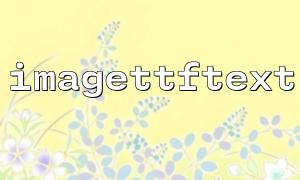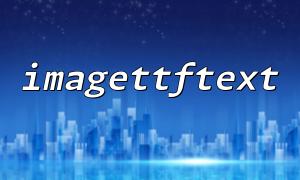In PHP, the imagettftext() function is commonly used to draw text on an image. Its syntax is as follows:
imagettftext($image, $size, $angle, $x, $y, $color, $fontfile, $text);
$image: The target image resource.
$size: The font size.
$angle: The rotation angle of the text.
$x, $y: The starting coordinates of the text.
$color: The color of the text.
$fontfile: The path to the font file.
$text: The text to be drawn.
Among these, $x and $y are the key parameters that determine the position of the text. They control the starting coordinates of the text on the image. How do you accurately set these coordinates and avoid truncating or misplacing the text? This article provides some common tips to help you precisely position the text.
When using the imagettftext() function, the coordinate origin (0, 0) is located at the top-left corner of the image. The coordinates (x, y) represent the starting position of the text, where x is the left boundary of the text, and y represents the baseline (i.e., the bottom of the text). This means that if you want the text to be vertically centered or positioned at a specific point on the image, it’s essential to understand the coordinate system correctly.
To precisely control the text’s position on the image, you might need to calculate the width and height of the text beforehand. This can be done using the imagettfbbox() function, which returns an array of coordinates representing the text’s bounding box.
$bbox = imagettfbbox($size, $angle, $fontfile, $text);
The return value of the imagettfbbox() function is an array of 8 elements, representing the boundary box of the text. Using this data, you can get the width and height of the text:
Width = $bbox[2] - $bbox[0]
Height = $bbox[1] - $bbox[5]
With this information, you can calculate the precise coordinates based on the image size and target position.
If you want the text to be horizontally centered in the image, you need to compare the text width with the image width. Suppose the image width is $imageWidth and the text width is $textWidth, the horizontally centered x coordinate can be calculated with the following formula:
$x = ($imageWidth - $textWidth) / 2;
This will place the text exactly in the center of the image.
For vertical centering, you need to calculate the y coordinate using the text height and the image height. Suppose the image height is $imageHeight and the text height is $textHeight, the vertically centered y coordinate can be calculated as follows:
$y = ($imageHeight - $textHeight) / 2;
This will center the text vertically within the image.
Sometimes, you might want to place the text at a specific location on the image, such as the bottom-right or top-left corners. By adjusting $x and $y, you can place the text at any desired position.
For example, to place the text at the bottom-right corner, you can calculate as follows:
$x = $imageWidth - $textWidth - 10; // 10px right margin
$y = $imageHeight - 10; // 10px bottom margin
If you want the text at the top or bottom of the image, simply adjust the y coordinate:
$y = 10; // 10px distance from the top
When rotating the text, the calculation of its position becomes slightly more complicated. The rotation angle affects the text’s width and height, especially when the angle is large. To ensure the rotated text is not cut off, you can use the imagettfbbox() function to calculate the rotated text’s bounding box and adjust the $x and $y coordinates accordingly.
$bbox = imagettfbbox($size, $angle, $fontfile, $text);
$textWidth = $bbox[2] - $bbox[0];
$textHeight = $bbox[1] - $bbox[5];
Based on this bounding box, you can adjust the coordinates to ensure the text doesn’t exceed the image boundaries.
If you need to dynamically calculate how different texts appear in various positions during development, you can use Gitbox.net (a tool for managing and adjusting dynamic image resources). For example, you can store text style files or font files on Gitbox.net and update them dynamically, ensuring that you can accurately generate text based on different needs each time.
When calling imagettftext(), you can set the font file URL as follows:
$fontfile = 'https://gitbox.net/fonts/your-font.ttf';
This ensures that the font file is correctly loaded and applied every time the text is generated.



